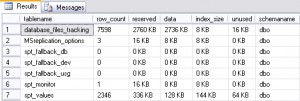I pulled apart a few stored procedures and ended up with this code. Very nice way to query the row count and size for each table. Take a look at the code, it is simpler than you might think. To use, change the database name at the top of the script to any database you wish to query. I turned this into a really handy stored procedure. When I call the stored procedure I pass the database name. Possibilities are endless.
use master
go
BEGIN try
DECLARE @table_name VARCHAR(500) ;
DECLARE @schema_name VARCHAR(500) ;
DECLARE @tab1 TABLE(
tablename VARCHAR (500) collate database_default
, schemaname VARCHAR(500) collate database_default
);
DECLARE @temp_table TABLE (
tablename sysname
, row_count INT
, reserved VARCHAR(50) collate database_default
, data VARCHAR(50) collate database_default
, index_size VARCHAR(50) collate database_default
, unused VARCHAR(50) collate database_default
);
INSERT INTO @tab1
SELECT t1.name
, t2.name
FROM sys.tables t1
INNER JOIN sys.schemas t2 ON ( t1.schema_id = t2.schema_id );
DECLARE c1 CURSOR FOR
SELECT t2.name + '.' + t1.name
FROM sys.tables t1
INNER JOIN sys.schemas t2 ON ( t1.schema_id = t2.schema_id );
OPEN c1;
FETCH NEXT FROM c1 INTO @table_name;
WHILE @@FETCH_STATUS = 0
BEGIN
SET @table_name = REPLACE(@table_name, '[','');
SET @table_name = REPLACE(@table_name, ']','');
-- make sure the object exists before calling sp_spacedused
IF EXISTS(SELECT OBJECT_ID FROM sys.objects WHERE OBJECT_ID = OBJECT_ID(@table_name))
BEGIN
INSERT INTO @temp_table EXEC sp_spaceused @table_name, false ;
END
FETCH NEXT FROM c1 INTO @table_name;
END;
CLOSE c1;
DEALLOCATE c1;
SELECT t1.*
, t2.schemaname
FROM @temp_table t1
INNER JOIN @tab1 t2 ON (t1.tablename = t2.tablename )
ORDER BY schemaname,tablename;
END try
BEGIN catch
SELECT -100 AS l1
, ERROR_NUMBER() AS tablename
, ERROR_SEVERITY() AS row_count
, ERROR_STATE() AS reserved
, ERROR_MESSAGE() AS data
, 1 AS index_size, 1 AS unused, 1 AS schemaname
END catch
The results look like this:
Looks great.

